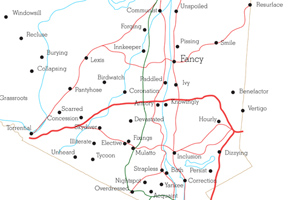R. Luke DuBois: A More Perfect
Bitforms Gallery, NYC
Through February 19, 2011
Feo Belcari of Florence wrote in 1449: "The Eye is called the first of all the gates/Through which the Intellect may learn and taste/The Ear is second, with the attentive Word/That arms and nourishes the Mind." The basic premise of these lines is underscored in A More Perfect Union R. Luke DuBois exhibition at Bitforms. We are taught, early on, that the eye, the window to the soul, is also the first portal through which desire enters -- bringing with it, and upon us, the seed of The Deadly Sins.
DuBois has created an exhibit of the data he compiled using internet dating sites to gather information on the tastes and predilections of those using them. Long a haven for geeks and pedophiles, the use by artists of its myriad information has become more timely, and hopefully of some social benefit. DuBois writes: "Online dating forces us to engage in a vulnerable act of articulating our self-identity in a semi-public forum for the express purpose of being wanted. To read a thoughtful dating profile or view a profile photo is to view the precarious expression of someone else’s desires." Presenting himself in a variety of guises and through different IP addresses, DuBois both culled lists of words which appeared most often in the profiles he received, and organized them according to US census locations. He then created maps using the words he gathered, compiling a "romantic atlas" of the country, with keywords from these lists replacing cities and towns on the maps.
The series of prints displayed in the gallery resemble 70s "information art" with their retro feeling of "fact". What sets DuBois project firmly into the realm of Art is his manipulation of our dating foibles into something vaguely ontological. Artists such as Matta-Clark and Bochner set the precedent for this type of work, making facts hew toward a specific end. This in and of itself is not harsh criticism of DuBois project, it merely points up the inherent potential of all surveys to skew to a predetermined end. Or, as David Byrne once put it: "Facts are strange, facts are true/Facts don’t do what I want them to."
Also, and possibly more than an accidental aside, DuBois sought to critique the system without taking into account the ghost in the machine. Online servers filter out and exclude information, sometimes relevant, sometimes not, to the subject being discussed. In this case, dating, we find no mention in any of the words gathered of N.M.B.L.A, or Jihad. One would think D/S or BDSM might make an appearance; but apparently either they were pre-filtered, or did not appear enough to make the head-count. Tangentially, dating code-words and phrases, like "still skiing" or "pay with flowers" might defy categorization. Although, in light of the Craigslist Killer, or those who troll for "candy" and "chicken," specificity of language, and our relationship to its consequences, might seem to have more import than it is assumed.
In the end, this exhibition turns less on concepts like this, and more on our relationship to each other. There is a romantic underpinning to the project that is belied by its somewhat cold presentation. After all, DuBois did spend an awful lot of time on the dating sites, and it is not unfair to assume that buried beneath the conceptual nature of the project there might have been an underlying presumption of desire on the artists part. All great art is born from an element of Truth; here we find, even veiled with technology, that premise still holds. Touching from a distance.

